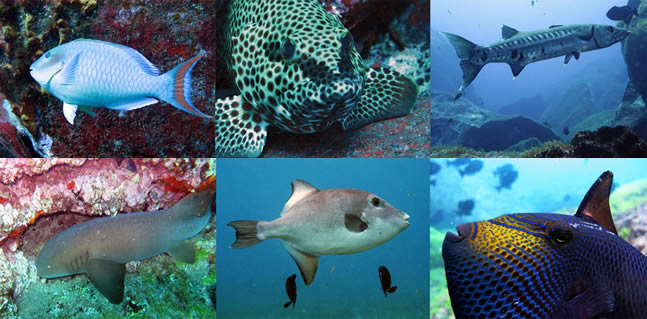Expeditions: Trindade Island - 2016
Trindade Island, one of the most interesting geological and ecological Brazilian patrimony , also included in the
named “Blue Amazon”1, had been visited by scientists from LECAR-UFF (Matheus Pacheco) and LBMM-UFSC
(Anderson A. Batista) on June, 2016. The expedition initiative is part of ongoing biodiversity monitoring program on
Brazilian oceanic islands, but also includes a bio-prospection branch (PROSPECMAR/PELD and SISBIOTAmar net
research cooperation). The researchers conducted underwater visual censuses for reef fish abundance estimates.
The procedure intended to add data to a large data bank to understand variations of density and biomass in time.
Such information will also be analyzed to compare Trindade Island’s reef fish fauna with other oceanic islands
encompassed by the projects (e.g. Saint Peter and Saint Paul Archipelago, Fernando de Noronha and Atol das
Rocas). Scientists collected DNA samples of reef fishtop predators, that will be used to evaluate the
phylogeographic patterns of genetic connectivity among Oceanic Brazilian Islands and coast. The researches
sampled benthic photoquadrats to evaluate the possible natural and anthropogenic changes. On intertidal
habitats (rocky and sand beaches), researchers collected biometry data of red rocky crab populations (Grapsus
grapsus), to evaluate its community structure. Technical and logistic support was provided by the Brazilian Navy,
which also, keeps the scientific station operational.
1 The Blue Amazon, as Brazil’s authorities have begun to call this marine area rich in both biodiversity and energy
resources, is similar in extension to the country’s rainforest_nearly half the size of the national territory.

Fig.1: From left to right-A) Diving logistic support by Brazilian Navy; B) Divers descent; C) Benthic samples with
photoquadrats.

Fig.2: Examples of abundant local reef fish fauna. From left to right- A): Sparisoma amplum TP; b) Epinephelus
adscensionis; C) Sphyraena barracuda, d) Ginglymostoma cirratum; e) Canthidermis sufflamen; f) Melichthys niger.

Fig.3: From left to right-A): Grapsus grapsus. in its habitat; B) Biometry; C) G. grapsus predating new born sea turtle.
Written by: Anderson A. Batista
|












